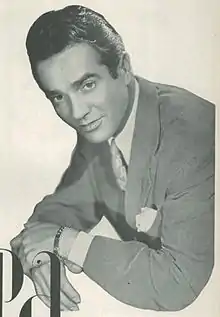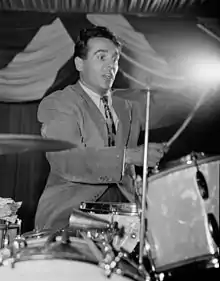Gene Krupa
Eugene Bertram Krupa (January 15, 1909 – October 16, 1973) was an American jazz drummer, band leader and composer known for his energetic style and showmanship.[1][2] His drum solo on "Sing, Sing, Sing" (1937) elevated the role of the drummer from an accompanying line to an important solo voice in the band.
Gene Krupa | |
|---|---|
 Krupa in 1944 | |
| Background information | |
| Birth name | Eugene Bertram Krupa |
| Born | January 15, 1909 Chicago, Illinois, U.S. |
| Died | October 16, 1973 (aged 64) Yonkers, New York, U.S. |
| Genres | Jazz, swing, Dixieland |
| Occupation(s) | Musician, composer, bandleader |
| Instruments | Drums |
| Years active | 1920s–1973 |
| Associated acts | Eddie Condon, Benny Goodman, Louie Bellson, Anita O'Day, Buddy Rich |
In collaboration with the Slingerland drum and Zildjian cymbal manufacturers, he was a major force in defining the standard band drummer's kit. Krupa is considered "the founding father of the modern drumset" by Modern Drummer magazine.[3]
Early life
The youngest of Anna (née Oslowski) and Bartłomiej Krupa's nine children, Gene Krupa was born in Chicago. Bartłomiej was an immigrant from Poland born in the village of Łęki-Górne, Podkarpackie in Southeastern Poland. Anna was born in Shamokin, Pennsylvania and was also of Polish descent. His parents were Roman Catholics who groomed him for the priesthood. He spent his grammar school days at parochial schools. He attended the James H. Bowen High School on Chicago's southeast side. After graduation he attended Saint Joseph's College for a year but decided the priesthood was not his vocation.
Krupa studied with Sanford A. Moeller, and began playing drums professionally in the mid-1920s with bands in Wisconsin. In 1927, he was hired by MCA to become a member of Thelma Terry and Her Playboys, the first notable American jazz band to be led by a female musician (except all-female bands). The Playboys were the house band at the Golden Pumpkin nightclub in Chicago and toured throughout the eastern and central United States.
Career

Krupa made his first recordings in 1927 with a band under the leadership of Red McKenzie and guitarist Eddie Condon. Along with other recordings by musicians from the Chicago jazz scene, such as Bix Beiderbecke, these recordings are examples of Chicago style jazz. Krupa's influences during this time included Father Ildefonse Rapp and Roy Knapp (both teachers of his), and drummers Tubby Hall, Zutty Singleton and Baby Dodds. Press rolls (dragging one stick across the snare head while keeping the beat with the other stick) were a fairly common technique in the early stages of his development. There were many other drummers (Ray Bauduc, Chick Webb, George Wettling, Dave Tough) who influenced his approach to drumming and other instrumentalists and composers such as Frederick Delius who influenced his approach to music.[4]
Krupa appeared on six recordings by the Thelma Terry band in 1928. In December 1934, he joined Benny Goodman's band, where his drum work made him a national celebrity. His tom-tom interludes on the hit "Sing, Sing, Sing" were the first extended drum solos to be recorded commercially.[5] But conflict with Goodman prompted him to leave the group and form his own orchestra shortly after the Carnegie Hall concert in January 1938. He appeared in the 1941 film Ball of Fire in which he and his band performed an extended version of the hit "Drum Boogie" (composed by Krupa and Roy Eldridge), sung by Martha Tilton and lip-synced by Barbara Stanwyck.
In 1943, Krupa was arrested on a trumped-up drug charge.[1][6] This resulted in a short jail sentence and bad publicity. Gene broke up the orchestra and returned to Goodman's band for a few months. When Goodman wanted him to go on a west coast tour, Gene (understandably) chose not to. He then joined Tommy Dorsey's band for several months and then put together his next orchestra.
As the 1940s ended, Count Basie closed his band and Woody Herman reduced his band to an octet. In 1951, Krupa cut down the size of his band to a ten-piece for a short while and from 1952 on he led trios, then quartets, often with Charlie Ventura then Eddie Shu on tenor sax, clarinet, and harmonica. He appeared regularly in the Jazz at the Philharmonic concerts. In the 1950s, Krupa returned to Hollywood to appear in the films The Glenn Miller Story and The Benny Goodman Story. In 1959, the movie biography The Gene Krupa Story was released; Sal Mineo portrayed Krupa, and the film included cameos by Anita O'Day and Red Nichols.[4] During the 1950s and 1960s, Krupa often played at the Metropole near Times Square in Manhattan. He continued to perform in famous clubs in the 1960s, including the Showboat Lounge in northwest Washington, D.C. With peer Cozy Cole, Gene started a music school in 1954 that carried on into the 1960s. Some of the school's students included Peter Criss of KISS and Jerry Nolan of The New York Dolls. Doug Clifford of Creedence Clearwater Revival cited Krupa as an inspiration. Krupa was still very busy in the early 1970s until shortly before his death. That included several reunion concerts of the original Benny Goodman Quartette. On April 17, 1973, the Gene Krupa Quartet, composed of Eddie Shu (tenor and clarinet), John Bunch (piano), Nabil Totah (Bass) and Krupa (drums), recorded a live performance at the New School featuring the Louis Prima composition "Sing, Sing, Sing".
His compositions which he wrote or co-wrote included "Some Like It Hot" in 1939, "Drum Boogie", "Boogie Blues", his theme song "Apurksody", "Ball of Fire", "Disc Jockey Jump" with Gerry Mulligan, "Wire Brush Stomp", "Hippdeebip", "Krupa's Wail", "Swing is Hee", "Quit and Roll 'Em" with Sam Donahue, and "How 'Bout This Mess".
Krupa-Rich drum battles
Norman Granz hired Krupa and drummer Buddy Rich for his Jazz at the Philharmonic concerts. The two drummers performed at Carnegie Hall in September 1952 and it was issued by Verve as The Drum Battle. The two drummers faced off in a number of television broadcasts and other venues and often played similar duets with drummer Cozy Cole. Krupa and Rich recorded two studio albums together: Krupa and Rich (Verve, 1955) and Burnin' Beat (Verve, 1962).
Personal life
Krupa married Ethel Maguire twice: the first marriage lasted from 1934 to 1942, the second from 1946 to her death in 1955. He remarried in 1959 to Patty Bowler and they were divorced within ten years.
In the early 1970s, Krupa's house in Yonkers, New York was damaged by fire.[7] He continued to live in the parts of the house that were habitable.
In 1973, Krupa died in Yonkers at the age 64 from heart failure, though he also had leukemia and emphysema.[8] He is buried in Holy Cross Cemetery in Calumet City, Illinois.
Endorsement

In the 1930s, Krupa became the first endorser of Slingerland drums. At Krupa's urging, Slingerland developed tom-toms with tuneable top and bottom heads, which immediately became important elements of virtually every drummer's setup. Krupa developed and popularized many of the cymbal techniques that became standard. His collaboration with Avedis Zildjian developed the modern hi-hat cymbals and standardized the names and uses of the ride cymbal, crash cymbal and splash cymbal. He is also credited with helping to formulate the modern drum set, being one of the first jazz drummers to use a bass drum in a recording session (December 1927).[6] One of his bass drums, a Slingerland 14 X 26, inscribed with Benny Goodman's and Krupa's initials, is preserved at the Smithsonian Institution in Washington, D.C.[9]
Awards and honors
In 1978, Krupa became the first drummer inducted into the Modern Drummer Hall of Fame. The 1937 recording of Louis Prima's "Sing, Sing, Sing (With a Swing)" combined with Waller's "Christopher Columbus" by Benny Goodman and His Orchestra featuring Krupa on drums was inducted into the Grammy Hall of Fame in 1982.
Discography
As leader
- 1952 The Original Drum Battle (Verve)
- 1952 The Drum Battle with Buddy Rich (Verve)
- 1953 Timme Rosenkrantz' 1945 Concert Vol. 3 (Commodore)
- 1953 The Exciting Gene Krupa
- 1954 Sing, Sing, Sing (Verve)
- 1954 The Driving Gene Krupa (Verve)
- 1954 Gene Krupa, Vol. 1 (Clef)
- 1954 Gene Krupa, Vol. 2 (Clef)
- 1955 The Jazz Rhythms of Gene Krupa (Verve)
- 1955 G. Krupa-L. Hampton-T. Wilson (Verve)
- 1955 The Gene Krupa Quartet (Clef)
- 1956 Drummer Man (Verve)
- 1956 Krupa and Rich (Verve)
- 1957 Krupa Rocks (Verve)
- 1959 Big Noise from Winnetka (Commodore)
- 1959 Plays Gerry Mulligan Arrangements (Verve)
- 1959 Hey...Here's Gene Krupa (Verve)
- 1959 The Gene Krupa Story (Verve)
- 1961 Percussion King (Verve)
- 1962 Burnin' Beat with Buddy Rich (Verve)
- 1963 The Mighty Two with Louis Bellson (Roulette)
- 1964 The Great New Gene Krupa Quartet Featuring Charlie Ventura (Verve)
- 1972 Jazz at the New School (Chiaroscuro)[10]
As sideman
With Benny Goodman
- 1950 Live at Carnegie Hall (1938)
- 1955 The Benny Goodman Story, Vols. 1–2
- 1956 The King of Swing, Vol. 2
- 1956 Trio Quartet Quintet
- 1997 The Complete RCA Victor Small Group Recordings (RCA Victor, 1935–39 [1997])
References
- Yanow, Scott. "Gene Krupa". AllMusic. Retrieved September 25, 2018.
- Spagnardi, Ron (1992). The Great Jazz Drummers. Hal Leonard Corporation. p. 35.
- "Gene Krupa: The Man Who Made It All Happen". Modern Drummer. Retrieved January 15, 2017.
- "Gene Krupa profile". Drummerman.net. Retrieved October 20, 2011.
- Bruce H. Klauber, World of Gene Krupa: That Legendary Drummin' Man, p. 13
- "Drummer World: Gene Krupa". Drummerworld.com. Retrieved January 28, 2015.
- Klauber, Bruce H. (1990). World of Gene Krupa: That Legendary Drummin' Man. Pathfinder. p. 166. ISBN 093479328X.
- "Death takes Gene Krupa at age 64". Bangor Daily News. UPI. October 17, 1973.
- ""Gene Krupa: a Drummer with Star Power" by Owen Edwards". Smithsonianmag.com. Retrieved June 25, 2012.
- "Gene Krupa | Album Discography | AllMusic". AllMusic. Retrieved September 26, 2018.
External links
| Wikimedia Commons has media related to Gene Krupa. |